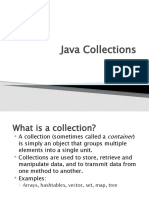JavaCollections Abbrev
Uploaded by
ankitgaur36JavaCollections Abbrev
Uploaded by
ankitgaur36Java Collection API :
Built-in Data Structures for Java
based on original presentation by C.-C. Chen
Transparency No. 1
Java Collection
The Java Collection API
Interfaces: Collection
Set SortedSet, List
Map SortedMap Iterator ListIterator Comparator
Transparency No. 2
Java Collection
Collection Interfaces : The primary means by which collections are manipulated. Collection Set, List
A group of objects. May or may not be ordered; May or may not contain duplicates.
Summary of all interfaces in the java Collection API
Set SortedSet
The familiar set abstraction. No duplicates; May or may not be ordered.
SortedSet
elements automatically sorted, either in their natural ordering (see the Comparable interface), or by a Comparator object provided when a SortedSet instance is created.
List
Ordered collection, also known as a sequence. Duplicates permitted; Allows positional access.
Transparency No. 3
Java Collection
Map SortedMap
A mapping from keys to values. Each key can map to at most one value (function).
SortedMap
A map whose mappings are automatically sorted by key, either in the keys' natural ordering or by a comparator provided when a SortedMap instance is created.
Transparency No. 4
Java Collection
classes of the java collection API
1. AbstractCollection (Collection)
AbstractSet (Set) HashSet, TreeSet(SortedSet) AbstractList (List) ArrayList, AbstractSequentialList LinkedList HashMap TreeMap (SortedMap) WeakHashMap
AbstractMap (Map)
Arrays Collections
Transparency No. 5
Java Collection
General-Purpose Implementation classes
The primary implementations of the collection interfaces. HashSet : Hash table implementation of the Set interface. TreeSet : Red-black tree implementation of the SortedSet interface. ArrayList : Resizable-array implementation of the List interface.
(Essentially an unsynchronized Vector.) The best all-around implementation of the List interface.
LinkedList : Doubly-linked list implementation of the List interface.
May provide better performance than the ArrayList implementation if elements are frequently inserted or deleted within the list. Useful for queues and double-ended queues (deques).
HashMap : Hash table implementation of the Map interface.
(Essentially an unsynchronized Hashtable that supports null keys and values.) The best all-around implementation of the Map interface.
TreeMap : Red-black tree implementation of the SortedMap interface.
Transparency No. 6
Java Collection
The java.util.Collection interface
represents a group of objects, known as its elements. no direct implementation The primary use : pass around collections of objects where maximum generality is desired. Ex: List l = new ArrayList( c ) ; // c is a Collection object
Transparency No. 7
Java Collection
The definition
public interface Collection { // Basic properties int size(); boolean isEmpty(); boolean contains(Object element); // use equals() for comparison boolean equal(Object); int hashCode(); // new equals() requires new hashCode() // basic operations boolean add(Object); // Optional; return true if this changed boolean remove(Object); // Optional; use equals() (not ==)
Transparency No. 8
Java Collection
Why using Iterators instead of Enumerations
Iterator allows the caller to remove elements from the underlying collection during the iteration with well-defined semantics. Method names have been improved. public interface Iterator { boolean hasNext(); // cf: hasMoreElements() Object next(); // cf: nextElement() void remove(); // Optional } // a simple Collection filter using iterator that Enumeration could not help static void filter(Collection c) { for (Iterator i = c.iterator(); i.hasNext(); ) { if ( no-good( i.next() ) ) i.remove(); // i.next() is removed from c i.remove(); // exception raised, cannot remove more than once ! }}
Transparency No. 9
Java Collection
is a Collection that cannot contain duplicate elements. models the mathematical set abstraction. contains no methods other than those inherited from Collection.
same signatures but different semantics ( meaning ) Collection c = new LinkedList(); Set s = new HashSet(); String o = a; c.add(o); c.add(o) ; // both return true; c.size() == 2 s.add(o); s.add(o) ; // 2nd add() returns false; s.size() == 1
The Set Interface
It adds the restriction that duplicate elements are prohibited.
Collection noDups = new HashSet(c); // a simple way to eliminate duplicate from c
Two Set objects are equal if they contain the same elements. Two direct implementations:
HashSet TreeSet
Transparency No. 10
Java Collection
Basic Operations
A simple program to detect duplicates using set: import java.util.*; public class FindDups { public static void main(String args[]) { Set s = new HashSet(); // or new TreeSet(), another implementation of Set // following code uses Set methods only for (int i=0; i<args.length; i++) if (!s.add(args[i])) System.out.println("Duplicate detected: + args[i]); System.out.println(s.size()+" distinct words detected: "+s); }} % java FindDups i came i saw i left Duplicate detected: i Duplicate detected: i 4 distinct words detected: [came, left, saw, i]
Transparency No. 11
Java Collection
The Map Interface
A Map is an object that maps keys to values. A map cannot contain duplicate keys: Each key can map to at most one value. Three implementations:
HashMap, which stores its entries in a hash table, is the bestperforming implementation. TreeMap, which stores its entries in a red-black tree, guarantees the order of iteration. Hashtable has also been retrofitted to implement Map.
All implementation must provide two constructors: (like Collections) Assume M is your implementation
M() // empty map M(Map m) // a copy of map from m
Transparency No. 12
Java Collection
The Map interface
public interface Map { // Map does not extend Collection // Basic Operations // put or replace, return replace object // NOTE: different from Weisss insert(Hashable x) Object put(Object key, Object value); // optional Object get(Object key); Object remove(Object key); boolean containsKey(Object key); boolean containsValue(Object value); int size(); boolean isEmpty();
Transparency No. 13
Java Collection
The Map interface
// Bulk Operations void putAll(Map t); //optional void clear(); // optional // Collection Views; // backed by the Map, change on either will be reflected on the other. public Set keySet(); // cannot duplicate by definition!! public Collection values(); // can duplicate public Set entrySet(); // no equivalent in Dictionary // nested Interface for entrySet elements public interface Entry { Object getKey(); Object getValue(); Object setValue(Object value); }}
Transparency No. 14
Java Collection
Basic Operations
a simple program to generate a frequency table import java.util.*; public class Freq { private static final Integer ONE = new Integer(1); public static void main(String args[]) { Map m = new HashMap(); // Initialize frequency table from command line for (int i=0; i<args.length; i++) { Integer freq = (Integer) m.get(args[i]); // key is a string m.put(args[i], (freq==null ? ONE : new Integer( freq.intValue() + 1))); } // value is Integer System.out.println( m.size()+" distinct words detected:"); System.out.println(m); } } > java Freq if it is to be it is up to me to delegate 8 distinct words detected: {to=3, me=1, delegate=1, it=2, is=2, if=1, be=1, up=1}
Transparency No. 15
Java Collection
Collection Views methods
allow a Map to be viewed as a Collection in three ways:
keySet: the Set of keys contained in the Map. values: The Collection of values contained in the Map. This Collection is not a Set, as multiple keys can map to the same value. entrySet: The Set of key-value pairs contained in the Map. The Map interface provides a small nested interface called Map.Entry that is the type of the elements in this Set.
the standard idiom for iterating over the keys in a Map: for (Iterator i = m.keySet().iterator(); i.hasNext(); ) { System.out.println(i.next()); if(no-good()) i.remove() ; } // support removal from the back Map Iterating over key-value pairs for (Iterator i=m.entrySet().iterator(); i.hasNext(); ) { Map.Entry e = (Map.Entry) i.next(); System.out.println(e.getKey() + ": " + e.getValue()); }
Transparency No. 16
Java Collection
Actual Collection and Map Implementations
Implementations are the actual data objects used to store collections (and Maps). Three kinds of implementations: General-purpose Implementations
the public classes that provide the primary implementations of the core interfaces.
Wrapper Implementations
used in combination with other implementations (often the generalpurpose implementations) to provide added functionality.
Convenience Implementations
Convenience implementations are mini-implementations, typically made available via static factory methods that provide convenient, efficient alternatives to the general-purpose implementations for special collections (like singleton sets).
Transparency No. 17
Java Collection
General Purpose Implementations
Hash Table
Resizable array
balanced tree TreeSet (sortedSet)
linked list
Set
HashSet ArrayList Vector HashMap Hashtable
List
LinkedList TreeMap (sortedMap)
Map
Transparency No. 18
Java Collection
Properties of the implementations
consistent names as well as consistent behavior. full implementations [of all the optional operations]. All permit null elements, keys and values. unsynchronized.
remedy the deficiency of Hashtable and Vector can become synchronized through the synchronization wrappers
All have fail-fast iterators, which detect illegal concurrent modification during iteration and fail quickly and cleanly. All are Serializable, all support a public clone() method. should be thinking about the interfaces rather than the implementations. The choice of implementation affects only performance.
Transparency No. 19
Java Collection
HashSet vs treeSet (and HashMap vs TreeMap)
HashSet/ HashMap is much faster (constant time vs. log time for most operations), but offers no ordering guarantees. always use HashSet/HashMap unless you need to use the operations in the SortedSet, or in-order iteration. choose an appropriate initial capacity of your HashSet if iteration performance is important.
The default initial capacity is 101, and that's often more than you need. can be specified using the int constructor. Set s= new HashSet(17); // set bucket size to 17
Transparency No. 20
Java Collection
The Collections class
static int binarySearch(List list, Object key [, Comparator c]) static void copy(List dest, List src) // foreach i d.set(i, s.get(i)); static Enumeration enumeration(Collection c)
Returns an enumeration over the specified collection.
static void fill(List list, Object o) static Object max(Collection coll [, Comparator comp] ) static Object min(Collection coll [, Comparator comp] ) static List nCopies(int n, Object o) static void reverse(List l) static Set singleton(Object o) static Comparator reverseOrder() // assume a is of type String[] // usage: Arrays.sort(a, Collections.reverseOrder()); static void shuffle(List list [, Random rnd]) static void swap(List, int, int) static void rotate(List, int d) ;// obj at i moved to ( i - d mod size())
Transparency No. 21
You might also like
- Java List Collection Tutorial and ExamplesNo ratings yetJava List Collection Tutorial and Examples15 pages
- Java's Collection Framework: Another Use of Polymorphism Via InterfacesNo ratings yetJava's Collection Framework: Another Use of Polymorphism Via Interfaces23 pages
- Java Collections: // Declare The List Concrete Type Is ArraylistNo ratings yetJava Collections: // Declare The List Concrete Type Is Arraylist4 pages
- Collections in Java: Arrays Iterators Collections (Also Called Containers)No ratings yetCollections in Java: Arrays Iterators Collections (Also Called Containers)33 pages
- CSE/IT 213 - Eclipse, Collections, and Exceptions: New Mexico TechNo ratings yetCSE/IT 213 - Eclipse, Collections, and Exceptions: New Mexico Tech58 pages
- List of Five Checked and Unchecked ExceptionsNo ratings yetList of Five Checked and Unchecked Exceptions19 pages
- Java Collections: Object-Oriented ProgrammingNo ratings yetJava Collections: Object-Oriented Programming20 pages
- The Map Interface (The Java™ Tutorials Collections Interfaces)No ratings yetThe Map Interface (The Java™ Tutorials Collections Interfaces)6 pages
- Java Collections and Generics: - Prashant KumarNo ratings yetJava Collections and Generics: - Prashant Kumar48 pages
- Java's Collection Framework: Another Use of Polymorphism Via InterfacesJava's Collection Framework: Another Use of Polymorphism Via Interfaces
- Java Collections: // Declare The List Concrete Type Is ArraylistJava Collections: // Declare The List Concrete Type Is Arraylist
- Collections in Java: Arrays Iterators Collections (Also Called Containers)Collections in Java: Arrays Iterators Collections (Also Called Containers)
- CSE/IT 213 - Eclipse, Collections, and Exceptions: New Mexico TechCSE/IT 213 - Eclipse, Collections, and Exceptions: New Mexico Tech
- The Map Interface (The Java™ Tutorials Collections Interfaces)The Map Interface (The Java™ Tutorials Collections Interfaces)
- Advanced C Concepts and Programming: First EditionFrom EverandAdvanced C Concepts and Programming: First Edition



























































